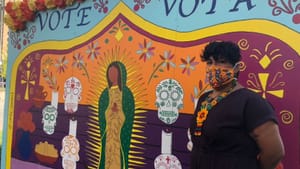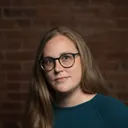Stay in the Loop
BSR publishes on a weekly schedule, with an email newsletter every Wednesday and Thursday morning. There’s no paywall, and subscribing is always free.
Just in case it needs to be said
Here’s why you aren’t seeing articles about Trump in BSR this election season

It’s not an accident that for the last several months, BSR has been peculiarly Trump-free. It’s not that we aren’t aware of the shameful antics at the White House this year, or that we don’t think they’re important, or that we have nothing to say, or that we think they’ll go away if we ignore them, or that we’re “not political.”
I like the school of thought that says there’s no such thing as “staying out of politics.” You’re either comfortable with the political status quo or you’re not, and you act (or don’t act) accordingly.
Getting political
If you believe, like the BSR team does, that everyone should be able to find and access cultural events and materials that represent and include them, then you’re getting political too. But since thousands of publications are already doing a great job of covering every move our astonishingly corrupt and incompetent president makes, we don’t think he’s worth any extra oxygen at BSR.
Instead, consistent with our Philly-centric mission, we’d rather focus our platform on the locals who are working to ensure that the most vulnerable members of our community are represented and empowered, despite our top officials’ constant attempts to thwart, impoverish, imperil, disenfranchise, disrespect, or demonize them.
That’s part of why I enjoyed speaking with Philly-based artist Candy Alexandra González, whose mural, Altar to our voting rights ancestors / Altar a los ancestros que lucharon por derechos del votante, is among six now on display in Love Park, part of a nonpartisan initiative from Mural Arts Philadelphia titled To the Polls 2020.
“Their voice matters”
González’s mural includes text in English and Spanish. “I want the Spanish-speaking immigrants in Philly to feel acknowledged,” they said. Throughout this election cycle, González notes, these people have been villainized, ignored, or tokenized. “I want them to feel seen and I want them to know that their voice matters. Their vote matters, for those who can vote … It’s important for us to really recognize the prominence of Spanish-speaking immigrants and their role in our society.”

González’s mural represents a traditional Day of the Dead altar, including sugar skulls, bread, and drink that are offerings for people who have passed, along with the Virgen de Guadalupe, who, to the artist, symbolizes hope for immigrants in the US.
The bright yellow in the mural evokes marigolds, whose color González calls “the guiding light for our ancestors to find a way back to the land of the living,” because this mural is dedicated to civil-rights activists of the past like Ida B. Wells and Carrie Williams Clifford. “This is really a way to call in their spirit,” the artist says, and “have that power with us and ask them to guide us into an uncertain future.”
The mural is also a nod to González’s roots. They grew up in Miami, but their mom is from the Mexican state of Hidalgo, and the flowers and patterns in the mural are inspired by the traditional Tenango embroidery of that region. When González moved to Philly, they started their own altar practice as a way of staying connected to loved ones and their culture, and show gratitude.
Before they vote
As the artists finished their murals, To the Polls 2020 curator Conrad Benner said he was thinking about how close they stood to City Hall’s Octavius Catto monument. Benner called Catto “a hero who fought for our right to vote,” and makes him remember “this is a duty, a responsibility that so many people fought for.”
Alongside González, the installation features murals by D’nae Harrison, Kah Yangni, Khalid Dennis, Hysterical Men, and Nathaniel Lee, plus a structure by Aram Han Sifuentes called Voting Station for the Disenfranchised, featuring work from MAP’s art education students. It notes that more than a quarter of the US population can’t vote, and that the largest segment of that population is youth.

With a QR code on the structure, you can download a zine from the students, the culmination of a project begun in late 2019. “We want advocacy, we want awareness, so that when they are 18 and they are able to vote, they’re ready to make those informed decisions,” including on important local races, says Alaina Ewins, who teaches at MAP with Samuel Rodriguez, who was also on hand at a preview event.
“The young people are leading the way to help motivate and encourage other people to [vote],” Rodriquez said. “The young people are going to represent and show up.”
Don’t stop living
González understands that a lot of people are feeling fatigued, discouraged, or hopeless this election season. “I have had moments where I don’t know what to do and how to move forward. When we stop hoping and we stop pushing forward, we stop living in many ways,” they said. “Giving up and losing hope is really not an option. For folks who are feeling uncertain about whether their vote counts or not, it does. All of our lives are on the line. Everybody can contribute in different ways.”
After I spoke with To the Polls artists, I walked to City Hall to drop off my completed mail-in ballot, joining a line of other voters that stretched from the south entrance of City Hall, past Catto, around the building’s southwest corner, and into Dilworth Park. (October 19 is the last day before the November 3 election that you can register to vote. Pennsylvania residents should visit here. If you’re already registered, make your voting plan now.)
To figures like our current president, our focus on work like González’s is a way of saying here is what’s flourishing in the world despite you. And because that’s where we’re putting our attention and energy, that is what will flourish in our world long after number 45 is gone.
Image description: Nonbinary artist Candy Alexandra González, wearing a black tunic and an orange mask with colorful floral embroidery, stands outside next to their mural, which says “Vote” in Spanish and English and has candy skulls, floral designs, and the Virgen de Guadalupe. The mural’s main colors are blue, maroon, yellow, and green.
Image description: Nonbinary artist Kah Yangni stands in profile in front of their mural, pouring pink paint out of a can. They are wearing jeans and a pink t-shirt. The purple, blue, pink, and yellow mural has a large brown silhouette of a person’s profile and hands reaching upward, and the words “I vote to protect the people I love.”
Image description: A single-file line of dozens of voters with their backs to the camera, growing small in the distance, follows the giant base of Philadelphia’s City Hall.
What, When, Where
To the Polls 2020 will be on view for free in Love Park through November 3, 2020. Mural Arts will host a free virtual panel discussion featuring curator Conrad Benner and the artists on October 22 at 5:30pm. Register here.
Sign up for our newsletter
All of the week's new articles, all in one place. Sign up for the free weekly BSR newsletters, and don't miss a conversation.

 Alaina Johns
Alaina Johns